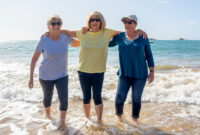Best senior trips represent a unique opportunity for fulfilling travel experiences tailored to the specific needs and desires of older adults. This exploration delves into the key factors influencing the choice of a perfect trip, from accessibility and pace to cost and personal interests. We’ll examine various trip types – cruises, guided tours, and independent travel – highlighting their advantages and disadvantages for seniors. The importance of addressing physical limitations and health concerns during the planning process will also be addressed, ensuring a safe and enjoyable journey for everyone.
We’ll showcase popular destinations categorized by interests, providing detailed descriptions and comparing accessibility features and cost ranges. Furthermore, we’ll cover practical aspects of trip planning, including booking flights and accommodations, utilizing travel agencies, and creating a comprehensive step-by-step guide. Health and safety considerations, both domestically and internationally, will be emphasized, along with enriching the travel experience through cultural immersion, social interaction, and opportunities for personal growth. Finally, illustrative examples of diverse senior trips – relaxing beach vacations, culturally immersive journeys, and active adventures – will bring these concepts to life.
Defining “Best” Senior Trips
Planning the perfect senior trip requires careful consideration of various factors, ensuring the experience is enjoyable, safe, and memorable. The definition of “best” is highly personalized and depends on individual preferences, physical capabilities, and budget. This section explores key elements contributing to a successful senior travel experience.
Factors Seniors Prioritize When Choosing a Trip
Choosing a senior trip involves balancing desired experiences with practical considerations. Seniors often prioritize accessibility, ensuring ease of movement and navigation throughout their journey. The pace of the trip is another crucial factor; some prefer a relaxed itinerary with ample downtime, while others might desire a more active schedule. Cost plays a significant role, with budget constraints influencing destination choices, accommodation, and activities. Finally, aligning the trip with personal interests, whether it’s exploring historical sites, enjoying nature, or engaging in cultural experiences, is essential for a fulfilling trip.
Comparison of Different Trip Types
Several trip types cater to different preferences and needs. Cruises offer all-inclusive packages with convenient onboard amenities, but can be less flexible in terms of itinerary and pace. Guided tours provide structure and expertise, easing logistical burdens, but might feel restrictive for some. Independent travel allows for maximum flexibility and personalization, but requires more planning and self-reliance. Each type presents trade-offs between convenience, cost, and freedom. For example, a guided tour of Europe might offer a comprehensive cultural experience at a higher price point than independent travel in a single country, which allows for a more leisurely pace but requires more self-directed planning. A cruise might be the most convenient option for those with mobility issues, but might lack the depth of cultural immersion offered by a guided tour.
Considering Physical Limitations and Health Concerns
Planning a senior trip necessitates a realistic assessment of physical limitations and health concerns. Pre-existing conditions like arthritis, heart problems, or mobility issues significantly influence trip choices. Selecting destinations with accessible transportation, accommodation, and attractions is crucial. It’s essential to choose a pace that doesn’t overexert participants and to build in rest periods. Travel insurance that covers medical emergencies is also a vital consideration. For instance, a trip involving extensive walking might be unsuitable for someone with severe arthritis, whereas a cruise might offer a more comfortable alternative. Similarly, individuals with heart conditions should avoid high-altitude destinations or strenuous activities.
Sample Accessible Senior-Friendly Trip Itinerary
This example focuses on a five-day trip to a coastal city known for its accessibility features.
| Day | Activity | Accessibility Considerations |
|---|---|---|
| 1 | Arrival and Check-in at Accessible Hotel | Hotel chosen for its wheelchair accessibility, ramps, elevators, and accessible rooms. |
| 2 | Guided Walking Tour of Historic Downtown (with rest stops) | Tour route chosen to minimize inclines and stairs; rest stops incorporated at regular intervals. Use of a wheelchair-accessible van for longer distances. |
| 3 | Visit to a Coastal Park with Accessible Boardwalk and Viewing Areas | Park selected for its wide, paved pathways, accessible restrooms, and ramps leading to scenic overlooks. |
| 4 | Relaxing Boat Trip with Accessible Boarding and Seating | Boat chosen for its ramps and accessible restrooms; seats with armrests and adequate space provided. |
| 5 | Departure | Accessible transportation arranged for travel to the airport. |
Popular Destinations for Senior Trips
Choosing the perfect senior trip involves considering various factors, from budget and accessibility to personal interests and desired pace. Many destinations cater specifically to the needs and preferences of older travelers, offering a blend of relaxation, exploration, and enriching experiences. This section explores some popular choices, categorized by interest, and provides detailed information on three diverse locations.
Popular Destination Categories by Interest
Senior travelers often seek destinations that align with their passions and physical capabilities. Therefore, popular destinations are often categorized by the types of activities and experiences they offer. This allows for a more tailored and enjoyable travel experience.
Detailed Descriptions of Three Diverse Destinations
Below is a table detailing three diverse destinations, highlighting their appeal to seniors. These destinations were selected to showcase a range of interests and accessibility levels.
| Destination | Activities | Accessibility | Cost Range |
|---|---|---|---|
| Charleston, South Carolina, USA | Exploring historic streets and architecture, carriage rides, visiting plantations, enjoying Southern cuisine, relaxing on the waterfront, attending cultural events. | Generally good accessibility with many historical sites offering wheelchair access and accessible transportation options available. However, cobblestone streets may present challenges for some. | Mid-range to Luxury, depending on accommodation and activities chosen. |
| Costa Rica | Observing diverse wildlife, relaxing on pristine beaches, exploring rainforests on accessible trails, enjoying eco-tourism activities (bird watching, zip-lining – adapted options available), experiencing the vibrant culture. | Accessibility varies depending on the specific activities and locations chosen. Many eco-lodges and tours offer accessible options, but independent exploration may require more planning and physical ability. | Mid-range to Luxury, depending on the chosen level of accommodation and the type of activities selected. All-inclusive resorts are a common option. |
| Kyoto, Japan | Visiting ancient temples and shrines, exploring traditional gardens, experiencing tea ceremonies, participating in cultural workshops (calligraphy, ikebana), enjoying delicious Japanese cuisine. | Accessibility can be challenging in some older areas with limited elevator access or uneven surfaces. However, many modern hotels and tourist attractions offer good accessibility features. Planning and research are crucial. | Mid-range to Luxury, depending on accommodation and chosen activities. Internal travel within Japan can add to the overall cost. |
Health and Safety Considerations
Planning a senior trip requires careful consideration of health and safety aspects to ensure a smooth and enjoyable experience. This section details precautions for both domestic and international travel, essential items for a first-aid kit, and strategies for managing potential health issues. Prioritizing health and safety allows seniors to focus on the enjoyment of their well-deserved trip.
Prioritizing health and safety is paramount when planning a senior trip, regardless of the destination. International travel often presents additional complexities, demanding more thorough preparation. Domestic trips, while generally simpler, still require careful consideration of potential health concerns and appropriate safety measures. Proactive planning minimizes risks and maximizes the chances of a worry-free adventure.
Necessary Precautions for Seniors Traveling Internationally or Domestically
Thorough preparation is key to a safe and healthy trip. This includes consulting with a physician well in advance of travel to discuss any pre-existing conditions, necessary vaccinations, and recommended medications. For international travel, researching visa requirements and necessary travel documents is crucial. Travel insurance is highly recommended, providing coverage for medical emergencies, trip cancellations, and lost luggage. Furthermore, familiarizing oneself with local emergency services and contacting the embassy or consulate of your home country in the destination country is vital. For domestic trips, similar precautions, albeit often less extensive, are equally important. Confirming travel arrangements, researching the destination’s safety and health conditions, and packing appropriately are essential steps.
Essential Items for a Senior’s Travel First-Aid Kit
A well-stocked first-aid kit is a crucial component of any senior’s travel preparations. The kit should include essential medications prescribed by a physician, such as heart medication, blood pressure medication, or insulin. Over-the-counter medications like pain relievers (acetaminophen or ibuprofen), anti-diarrheal medication, antacids, and motion sickness remedies should also be included. Additionally, bandages, antiseptic wipes, antibiotic ointment, gauze pads, and medical tape are necessary for treating minor injuries. A thermometer, tweezers, and a small pair of scissors are also helpful additions. Remember to check expiration dates on all medications and supplies before your trip. Consider including a list of allergies and current medications for easy reference in case of emergencies.
Strategies for Managing Potential Health Issues During a Trip, Including Emergency Contact Information
Having a comprehensive plan for managing potential health issues is essential. This involves carrying a list of emergency contacts, including family members, physicians, and local emergency services. Consider providing this information to someone travelling with you as well. It is also helpful to inform your bank and credit card companies of your travel plans to prevent any issues with transactions. For managing specific health conditions, such as diabetes or heart conditions, it’s crucial to pack enough medication and follow prescribed dosage instructions. If a medical emergency occurs, seek immediate medical attention and utilize your travel insurance if applicable. Keeping a detailed record of your medical history, including allergies and current medications, can be invaluable in such situations. Finally, staying hydrated and eating nutritious food throughout the trip will significantly improve overall health and well-being.
Enhancing the Senior Travel Experience
A well-planned senior trip goes beyond simply visiting a destination; it’s about crafting an experience that fosters rejuvenation, connection, and lasting memories. This involves thoughtfully incorporating elements that cater to the unique needs and interests of older travelers, ensuring the journey is both enjoyable and enriching.
Enhancing the senior travel experience involves a multifaceted approach, combining cultural immersion, social interaction, relaxation, and opportunities for personal growth. Careful consideration of these elements transforms a simple trip into a truly memorable and fulfilling adventure.
Cultural Immersion and Enrichment
Cultural experiences significantly enhance the value of a senior trip. Immersive activities could include attending local performances, visiting historical sites with guided tours tailored to the physical capabilities of the group, participating in cooking classes featuring regional cuisine, or engaging with local artisans to learn traditional crafts. For example, a trip to Italy could involve attending an opera in Verona, followed by a hands-on pasta-making class. This provides not only entertainment but also a deeper understanding and appreciation of the local culture. Similarly, a trip to Japan could include a tea ceremony and a visit to a traditional garden, offering a tranquil and culturally enriching experience.
The Benefits of Group Travel for Seniors
Group travel offers significant advantages for seniors. The shared experience fosters companionship and reduces feelings of isolation. Traveling with a group provides a built-in support system, offering assistance with navigation, luggage handling, and even providing emotional support during unexpected situations. Shared meals and activities create opportunities for bonding and making new friends, combating loneliness and enriching the overall experience. The sense of camaraderie created within a group can significantly enhance the enjoyment and memories of the trip. For instance, a group trip to a national park could involve hiking together, sharing stories around a campfire, and celebrating collective achievements.
Opportunities for Learning and Personal Growth
Incorporating opportunities for learning and personal growth can transform a senior trip into a journey of self-discovery. This could involve attending lectures or workshops related to the destination’s history, art, or culture. Visiting museums, historical sites, or attending local festivals can stimulate intellectual curiosity and provide new knowledge. Learning a few basic phrases in the local language can enhance interaction with locals and add a personal touch to the trip. For example, a senior trip to Peru could include a visit to Machu Picchu accompanied by a guided tour that delves into the history and significance of the site, fostering both physical activity and intellectual engagement.
Resources for Finding Senior-Specific Travel Deals and Discounts
Finding affordable travel options is crucial for many seniors. Several resources can help locate senior-specific deals and discounts:
- AARP: The AARP offers travel discounts and packages specifically designed for its members.
- Senior travel agencies: Numerous agencies specialize in catering to the needs and preferences of senior travelers, often offering competitive pricing and tailored itineraries.
- Travel websites: Many online travel agencies feature filters allowing users to search for senior-specific deals or discounts.
- Cruise lines: Several cruise lines offer special discounts and packages for seniors.
- Local tourism boards: Check local tourism websites; they sometimes offer senior discounts on attractions and activities.
Illustrative Examples of Senior Trips
Choosing the right senior trip depends heavily on individual preferences and physical capabilities. The examples below showcase diverse options catering to a range of interests and activity levels, highlighting the potential for enriching and memorable travel experiences.
Relaxing Beach Vacation in Barbados
Imagine waking to the gentle caress of a warm Caribbean breeze, the rhythmic sound of waves washing ashore a pristine beach. This Barbados getaway focuses on relaxation and rejuvenation. Picture yourself lounging on a sun-drenched beach, the soft white sand warming your skin. The turquoise waters shimmer invitingly, their gentle lapping a soothing balm for the soul. Days are spent leisurely strolling along the shore, enjoying the vibrant colours of tropical flowers, and perhaps indulging in a refreshing coconut water. Evenings bring the enchanting sounds of island music drifting on the breeze, coupled with the tantalizing aromas from nearby restaurants offering fresh seafood. Accommodations would include comfortable, accessible beachfront hotels or villas with amenities such as private balconies, spa facilities, and readily available assistance if needed. Excursions might involve a slow-paced boat trip to explore nearby coves, or a gentle guided walk through a lush tropical garden. The emphasis is on unhurried enjoyment and stress-free relaxation.
Culturally Immersive Trip to Italy
This trip prioritizes exploring Italy’s rich history and culture at a comfortable pace. The itinerary includes visits to iconic landmarks like the Colosseum in Rome and the Duomo in Florence, but with a focus on accessibility and manageable travel schedules. Seniors would enjoy guided tours with ample rest stops, utilizing comfortable, climate-controlled transportation such as private coaches or accessible train travel. Hotels are selected for their proximity to attractions and their provision of comfortable accommodations tailored to senior needs. Instead of rushing through multiple sites daily, the focus is on in-depth exploration of fewer locations, allowing for a more meaningful experience. Imagine the awe of witnessing the grandeur of the Roman Forum, followed by a leisurely lunch at a charming trattoria, savoring authentic Italian cuisine. The trip would also include opportunities to engage with local artisans and participate in cooking classes, offering deeper cultural immersion.
Adventure Trip in Costa Rica: Active Seniors Edition
This trip caters to active seniors who enjoy adventure, while prioritizing safety and accommodating varying fitness levels. Costa Rica’s diverse landscapes offer a range of activities suitable for different abilities. The itinerary might include guided nature walks through rainforests, with options for shorter, less strenuous trails for those with limited mobility. Zip-lining experiences are available with safety measures such as experienced guides and adaptable harnesses. For those who prefer a gentler pace, there are opportunities for birdwatching tours or relaxing boat trips on tranquil rivers. Accommodation would be in eco-lodges with accessible facilities, offering comfortable and safe environments. The trip emphasizes responsible eco-tourism, minimizing environmental impact and supporting local communities. Experienced guides ensure the safety of participants throughout the adventure, adapting activities to individual fitness levels and providing necessary support.
Closing Notes
Planning the ideal best senior trip involves a thoughtful consideration of various factors, from personal preferences and physical capabilities to budget and desired level of independence. By carefully weighing these elements and utilizing the resources and guidance provided, seniors can embark on enriching and memorable adventures that cater to their unique needs and desires. Remember, the goal is to create an experience that is both fulfilling and safe, allowing for cherished memories to be made.




